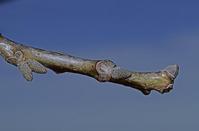|
Walnut
> Year-Round IPM Program > Dormant/Delayed
Dormant > Why Is This Season Important?
Walnut
 Why
Is the Dormant/Delayed-Dormant Season Important in an IPM
Program? Why
Is the Dormant/Delayed-Dormant Season Important in an IPM
Program?
Dormancy is generally defined as the period from leaf fall until
growth resumes in spring. Delayed
dormancy is the period from
the resumption of growth, indicated by bud swell, until flower
buds just begin to open. These periods vary according to region,
variety, and weather.
The dormant period is less critical for pest management activities
in walnuts than other fruit and nut crops. Several key insect
and mite pests such as navel orangeworm, scales, and European
red mites, overwinter in walnut orchards. It is an excellent
time for monitoring and assessing scales and mites because branches,
twigs, and buds are not hidden by leaves.
Dormant versus delayed-dormant oil treatments
Oil applied during the dormant period damages
walnut trees. However, oils can be safely used in some varieties
during the delayed-dormant season, but timing must be precise
because injury can also occur between budbreak and shoot elongation.
The main targets of delayed-dormant oil applications are scale
(European fruit lecanium, frosted scale, walnut scale) and
mites (European red mites). However, if you observe high rates
of parasitization, you may delay treatments until after crawlers
emerge in late spring when oil treatments are safer.
Water quality issues
Winter sanitation for navel orangeworm control
provides effective control and will reduce the need for pyrethroid
pesticide sprays at hull split that can run off with winter rains.
|


